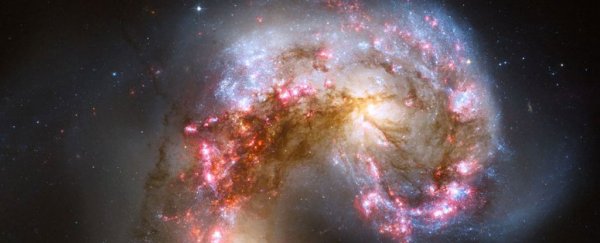Scientists have discovered a supermassive black hole with a mass 3 billion times that of the Sun, forming in a distant galaxy some 1.8 billion light-years away from Earth.
The galaxy in question is called IRAS 20100–4156, and it's formed from a trio of spiral galaxies that are in the midst of colliding into one another. The discovery of the supermassive black hole at the centre of this collision came by accident, during a test observation of the CSIRO's new telescope – the Australian Square Kilometre Array Pathfinder (ASKAP).
Astrophysicist Lisa Harvey-Smith was using the telescope to routinely measure the maser emissions coming from IRAS 20100–4156. "[I] thought it would be quite a mundane thing," she told Anna Salleh at the ABC.
But upon checking the readings in conjunction with measurements from another CSIRO telescope – the Australia Telescope Compact Array – Harvey-Smith found that the gas within the maser was travelling at crazy fast speeds.
Moving at about 600 kilometres per second around the centre of IRAS 20100–4156 – which was twice as fast as scientists would have expected – the speed of the gas hinted at a supermassive black hole forming at the centre of the galaxy.
"The black hole at the centre of our galaxy is only 4 million solar masses, so this one is a monster in comparison," Harvey-Smith told the ABC. "This very fast motion of the gas tells us about how massive the black hole is. The really exciting thing about this is it is a direct measurement of the mass of the black hole by stuff that's swirling around it."
When galaxies collide like this and form a supermassive black hole, it results in what's called a starburst, where stars form at an abnormally high rate.
According to Harvey-Smith, the discovery of monster black holes like this and knowing their mass helps give us a greater understanding of how galaxies form throughout the Universe.
"We want to know whether galaxy collisions, and the formation of supermassive black holes, have really driven the star formation rates that we see in galaxies and how that's changed throughout time," she told the ABC.
The paper has been accepted for publication in the Monthly Notices of the Royal Astronomical Society.
